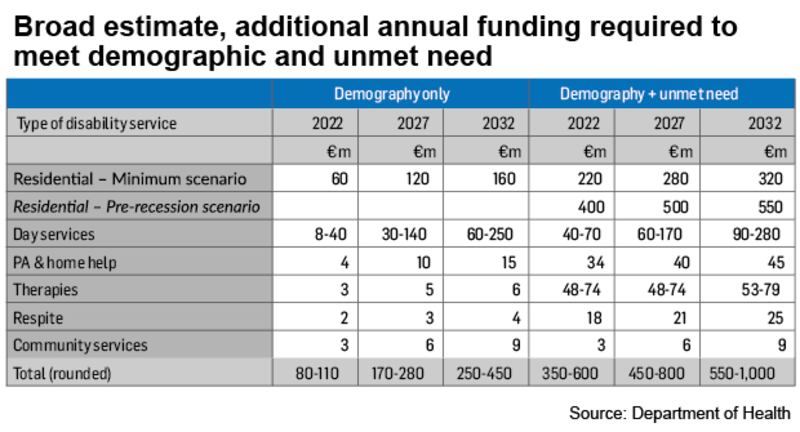The State’s spending on disability services will have to jump by up to half over the next 10 years, according to a major review of future needs by the Department of Health.
The predictions are contained in the Review of Disability Social Care Demand and Capacity Requirements up to 2032 prepared by the Department of Health, published on Thursday by Minister for Health Stephen Donnelly.
Between €500 million and €800 million may be needed in extra capital funding up to 2032 to pay for extra residential care housing, and to finish off the closure of the State’s ageing residential institutions.

The report concludes that while the Health Service Executive currently spends about €2.2 billion annually on disability services, there are existing “significant levels of unmet need”.
It says that changes in the size and age profile of the disability service population “will add to that over the coming decade”.
It says too that the costs of tackling these issues are “very significant” but that if no measures are taken, this unmet need will continue to grow and become more acute as the population ages.
“There will be a significant human cost for the individuals concerned and their families.”
The new report says addressing the capacity needed to deal with demographic change alone would not be sufficient, “as the current level of unmet need is not sustainable”.
The report says that about one in seven people in Ireland, or about 643,000, have a disability or long-term condition.
Additional investment
About 56,000 people receive services including early intervention, multidisciplinary therapies, habilitation, rehabilitation and behaviour support, staffed supported housing, specialist end-of-life care, respite/short breaks to support carers, day services and support for community engagement, personal assistance, home help and assistive technology.
The report says residential care services currently account forabout two-thirds of the specialist disability budget. It says about 8,300 people are receiving residential care support at an annual unit cost of some €144,000.
However it warns that significant additional investment will be needed.
“An average of about 90 new residential places will be needed every year from
2020 to 2032 to cater for changes in the size and age structure of the disability
population.”
However, it also maintains there is considerable unmet need for residential care.
“Access to residential care has fallen since the 2008 recession. Supply did not
keep up with population growth, but actually fell, as some places did not meet
regulatory standards.”
“The resulting shortfall is estimated to range from a minimum of 800 places, up to 2,300 places.”
The report says that significant waiting lists for residential care have emerged.
“These include people living with very elderly parents, and younger people
with complex medical needs or behavioural issues which require intensive
supports. The proportion of people with intellectual disability (ID) in residential care has fallen significantly from its pre-recession rate. In the absence of a planned programme to meet identified needs, there is only a limited pool of extra places provided for those classified as emergency. With such limited places, it is only those in the most extreme situations who are getting a residential place.”
‘Highest-need category’
The report says a minimum estimate drawn up in 2019 suggested there were about 800 people with unmet needs for a supported residential place.
“What is really striking is that almost 40 per cent of those listed, almost 300 people, were aged under 30. Such young people constituted almost half of those in the highest-need category of ‘emergency’. Typically, these are mostly male, have a combined diagnosis of intellectual disability, and autism and/or mental health difficulties, and a very high score on behaviour support needs. This is against a background of a halving of the rate of residential provision for young adults since the recession (from 17 per cent of those aged 20-24 on the national intellectual disability database in 2007 to 7 per cent in 2017). This has left behind a significant number of young people with very high support needs, whose current living arrangements with their families are no longer sustainable.”
The report says that to deal with both the backlog and with demographic change, overall an extra 1,900 residential places would be needed by 2032 under the minimum-need scenario and up to 3,900 more places to return to the situation prior to the recession after 2008.
The report says that, in addition replacement housing will be required for the outstanding 2,100 places currently provided in congregated settings.
“So the total number of residential places required will be of the order of 4,000 to 6,000 over the period to 2032. If all of these were to be four-person group homes, that would translate into an extra 1,000 to 1,500 such houses/apartments required. If there is a range of smaller and more personalised accommodation, then the number of additional housing units required would be greater.”
The Government said on Thursday that a detailed three-year action plan covering 2022-2025 was being developed which would identify “proposed strategic investment areas and associated key deliverables, to be achieved initially over a three-year time frame, that will provide access for people with a disability to the right services at the right time, enabling them to reach their potential, and play an active role in their own community”.











